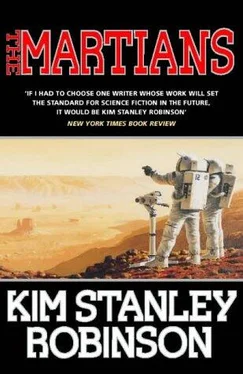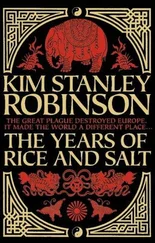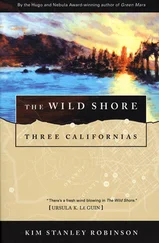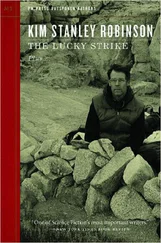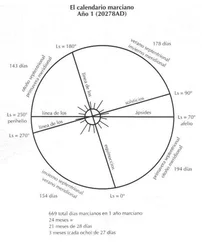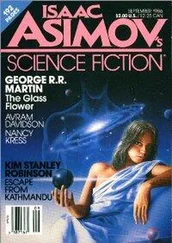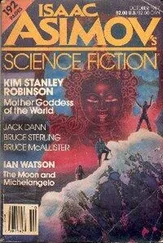Spectrographic analyses of the Shergotty and Zagami meteorites show that both diabase stones consist mainly of the pyroxenes pigeonite and augite, and of maskelynite, a shocked plagioclase glass. The maskelynite is zoned, with accessory phases of titanomagnetite, ilmenite, pyrrhotite, fayalite, tridymite, whitlockite, chlorapatite, and baddeleyite. In situ investigation of the brecciated diabase in SNC Crater and surrounding region reveal that ilmenite and whitlockite are missing from this inventory. Studies at another oval crater about the same age and size on the Elysium Massif, Crater Tf, show that it has the same brecciated diabase, with the same phase accessories, as SNC Crater and environs. The Crater Tf diabase also exhibits a poikilitic texture like that seen in the Chassigny meteorite (Banin, Clark, and Wänke, 1992). Either crater could have been the origin for the SNC meteorites so far found on Earth.
“Exotic Features in Archaea ceraunii Confirm Indigenous Origin.” Vol. 64, 1 April m69. By Forbes, G. N., Department of Biology, Sabishii College.
Proportions of isotropically heavy nitrogen unique to Mars are present in the archaea found 2.3 kms beneath the surface of Ceraunius Tholus, in ancient thermal springs. Mitochondrial analysis using the revised Thurmond equations confirms that Archaea ceraunii and the Columbia basement nanobacteria Methanospirillum jacobii split from a common ancestor from 6000 to 15,000 generations ago. Rates of mutation in extremophiles that have radically slowed their metabolisms are not yet certain, but there are strong indications that they may be well over a magnitude slower than described by earlier estimates (cf. Whitebook, H., m33f). This means the Ceraunius and Columbia nanobacteria could have split into separate species over 1.8 Gyr. Imbibition rates in basalt are <1 cm/Myr (cf. Russell et al., m12t), and not all of the Archaea ceraunii were found on the surfaces of cracked rocks in the thermal vent; some were recovered as much as a meter deep inside unbroken samples. These and other considerations show that Archaea ceraunii cannot have been placed in situ by anthropogenic action; there has not been enough time for them to get there. Indigenous origin is the only good explanation of all the data.
Keyword Search
In— The Journal of Areological Studies, vols. 65–75
Keyword—Archaea ceraunii
No match found.
Oh in those days we were so happy. In love, sure. Just the two of us; no kids; interesting work; lots of free time; all Mars there to be explored together. We would go out into the backcountry on long walkabouts, wandering and talking. Out under the stars at night. For several years we spent the fall in Odessa, where we had work in the vineyards and wineries. We rented a little house in the beach village a few kilometers west of Odessa, at the end of the tram line. A hillside village, looking down on a crook of a beach, buildings clustered at the bottom, scattered among the trees higher up. Our house was pretty high on the hill, with a view down over treetops and tile roofs, and the broad blue plate of the Hellas Sea. Little patio out back, a table and two chairs. A lot of flowering vines, a little lemon tree in a tub. Almost all the summer visitors would be gone by then, so that only one restaurant stayed open, down behind the beach. The cats were friendly and looked sleek and well fed, though no one owned them. In the restaurant one jumped right into my lap and purred. I remember the first time we stood on the patio, looking down, then back at the house—whitewash, vines, the bedroom balcony with an iron railing, the brown hills above and behind, the sea and the sky. We laughed at how perfect it was. Most mornings we trammed into town to work, then came back in the afternoons and went to the beach. Or vice versa. Sunset on the patio with a glass of wine. Dinners in our little kitchen, or down at the restaurant, where a guitar and mandolin duo played on Fridays. Then nights in bed in a house all to ourselves. Sometimes I woke before dawn and went down to start coffee and go out on the patio. One of those mornings the sky was plastered with a herringbone cloud that turned pink, then gold.
Chapter 22
Sexual Dimorphism
The potential for hallucination in paleogenomics was high. There was not only the omnipresent role of instrumentation in the envisioning of the ultramicroscopic fossil material, but also the metamorphosis over time of the material itself, both the DNA and its matrices, so that the data were invariably incomplete, and often shattered. Thus the possibility of psychological projection of patterns onto the rorschacherie of what in the end might be purely mineral processes had to be admitted.
Dr. Andrew Smith was as aware of these possibilities as anyone. Indeed it constituted one of the central problems of his field—convincingly to sort the traces of DNA in the fossil record, distinguishing them from an array of possible pseudofossils. Pseudofossils littered the history of the discipline, from the earliest false nautiloids to the famous Martian pseudonanobacteria. Nothing progressed in paleogenomics unless you could show that you really were talking about what you said you were talking about. So Dr. Smith did not get too excited, at first, about what he was finding in the junk DNA of an early dolphin fossil.
In any case there were quite a few distractions to his work at that time. He was living on the south shore of the Amazonian Sea, that deep southerly bay of the world-ringing ocean, east of Elysium, near the equator. In the summers, even the cool summers they had been having lately, the extensive inshore shallows of the sea grew as warm as blood, and dolphins—adapted from Terran river dolphins like the baiji from China, or the boto from the Amazon, or the susu from the Ganges, or the bhulan from the Indus—sported just off the beach. Morning sunlight lanced through the waves and picked out their flashing silhouettes, sometimes groups of eight or ten of them, all playing in the same wave.
The marine laboratory he worked at, located on the seafront of the harbor town Eumenides Point, was associated with the Acheron labs, farther up the coast to the west. The work at Eumenides had mostly to do with the shifting ecologies of a sea that was getting saltier. Dr. Smith’s current project dealing with this issue involved investigating the various adaptations of extinct cetaceans who had lived when the Earth’s sea had exhibited different levels of salt. He had in his lab some fossil material, sent to the lab from Earth for study, as well as the voluminous literature on the subject, including the full genomes of all the living descendants of these creatures. The transfer of fossils from Earth introduced the matter of cosmic-ray contamination to all the other problems involved in the study of ancient DNA, but most people dismissed these effects as minor and inconsequential, which was why fossils were shipped across at all. And of course with the recent deployment of fusion-powered rapid vehicles, the amount of exposure to cosmic rays had been markedly reduced. Smith was therefore able to do that research on mammal salt tolerance both ancient and modern, thus helping to illuminate the current situation on Mars, also joining the ongoing debates concerning the paleohalocycles of the two planets, now one of the hot research areas in comparative planetology and bioengineering.
Nevertheless, it was a field of research so arcane that if you were not involved in it, you tended not to believe in it. It was an offshoot, a mix of two difficult fields, its ultimate usefulness a long shot, especially compared to most of the inquiries being conducted at the Eumenides Point Labs. Smith found himself fighting a feeling of marginalization in the various lab meetings and informal gatherings, in coffee lounges, cocktail parties, beach luncheons, boating excursions. At all of these he was the odd man out, with only his colleague Frank Drumm, who worked on reproduction in the dolphins currently living offshore, expressing any great interest in his work and its applications. Worse yet, his work appeared to be becoming less and less important to his adviser and employer, Vlad Taneev, who as one of the First Hundred, and the cofounder of the Acheron labs, was ostensibly the most powerful scientific mentor one could have on Mars; but who in practice turned out to be nearly impossible to access, and rumored to be in failing health, so that it was like having no boss at all, and therefore no access to the lab’s technical staff and so forth. A bitter disappointment.
Читать дальше
Конец ознакомительного отрывка
Купить книгу
